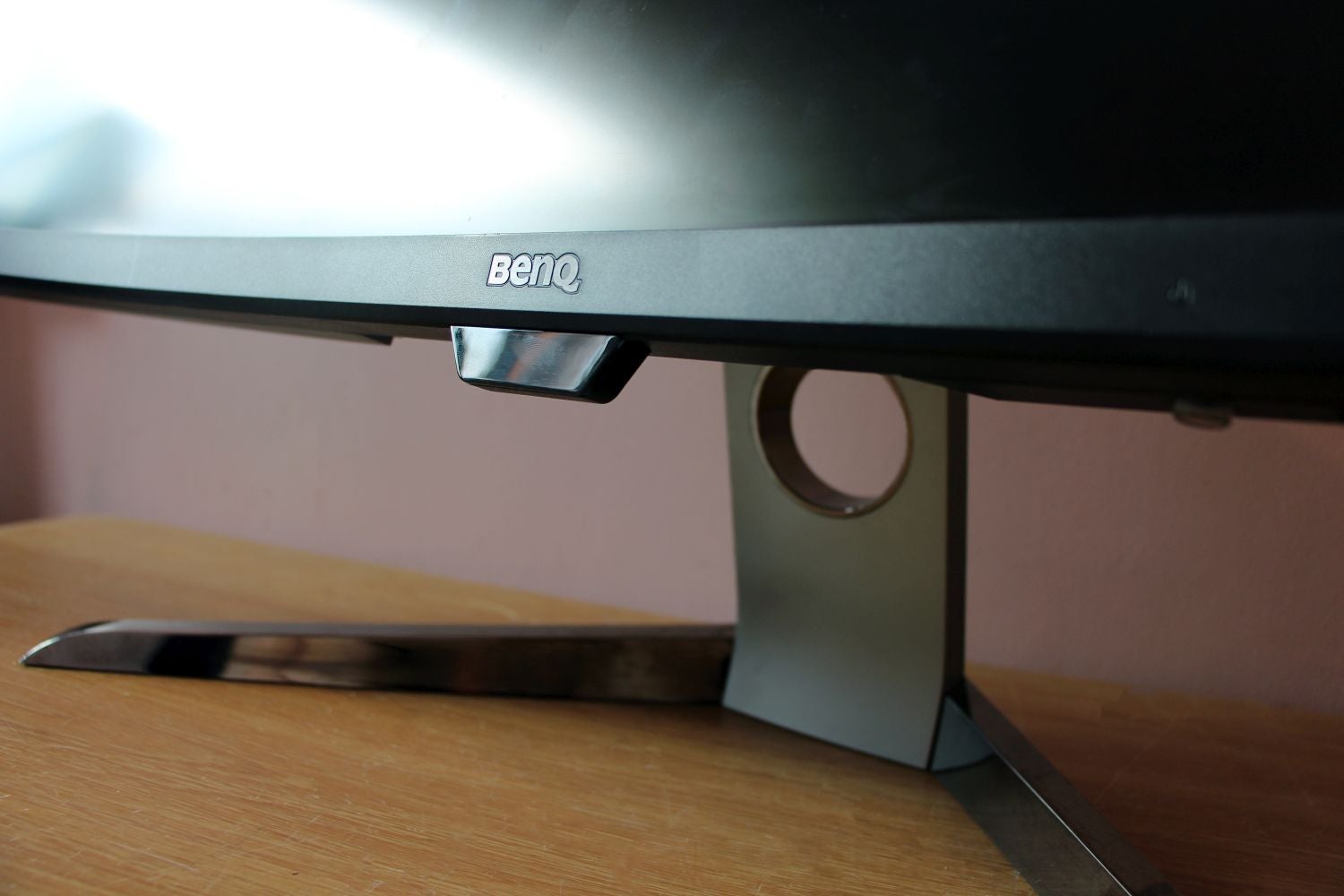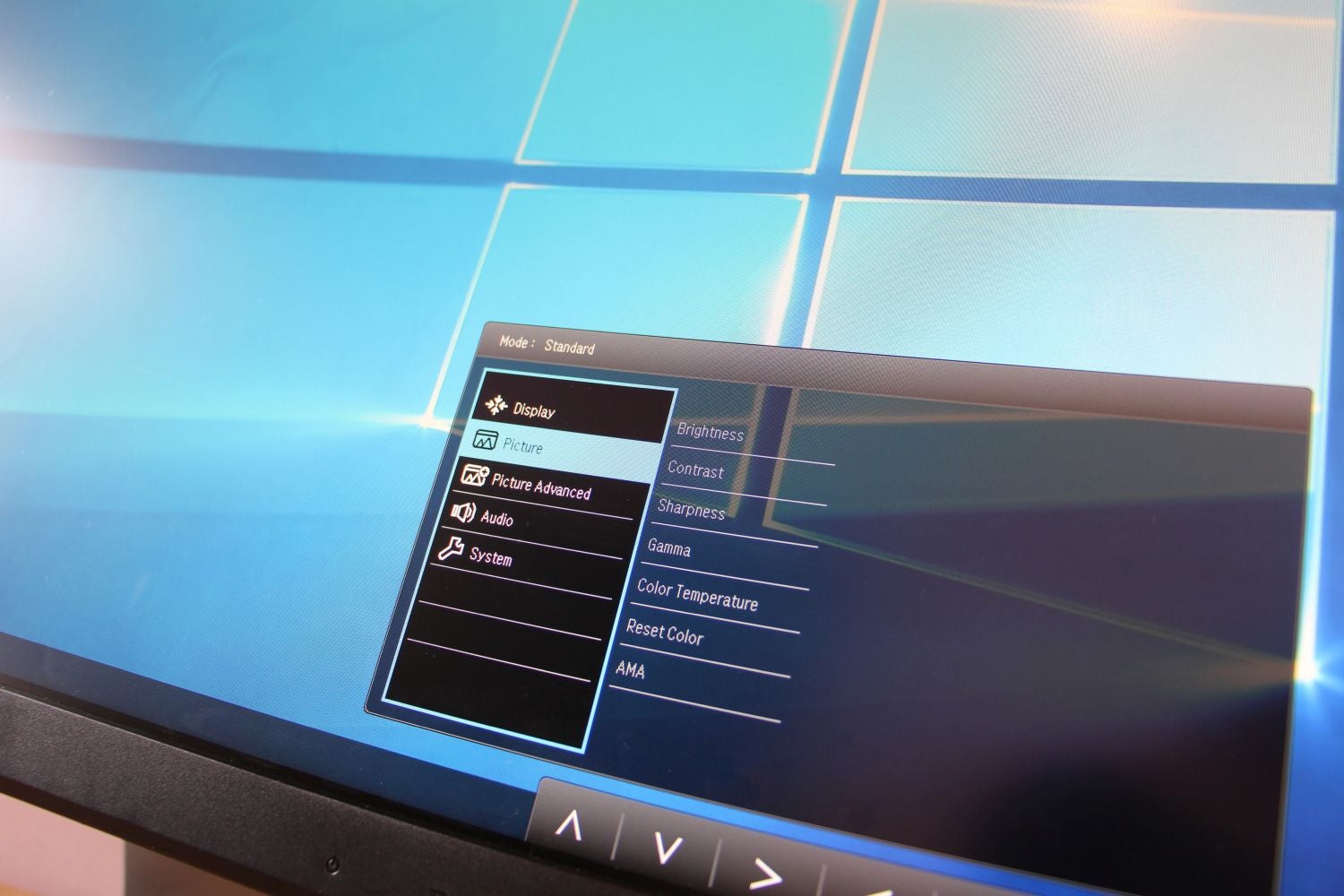BenQ EX3501R
What is the BenQ EX3501R?
It’s rare to find a monitor with a specification as all-encompassing as this, but the BenQ Ex3501R has managed it. This vast 35-inch unit is a 1440p widescreen panel with a tempting curved design – and it also packs in AMD FreeSync and HDR compatibility.
That’s a lot on the table, but it also means a high price. You’ll have to pay £625 to get your hands on the BenQ EX3501R.
BenQ EX3501R – Design and Features
The BenQ EX3501R panel has a radius of 1800R (i.e. if you had enough 1800R’s placed side by side so that they formed a circle, that circle’s radius would by 1800mm) which is the standard for curved screens. It’s got a 3440 x 1440 resolution stretched across its 35-inch diagonal. The panel underneath uses VA (vertical alignment) technology, instead of the more common IPS (in-plane switching) and TN (twisted nematic). VA type screens typically sit somewhere in between IPS and TN, promising a compromise between the high viewing angles you get with IPS screens and fast response times TN panels can offer. Black uniformity is generally better on VA panels than it is on IPS types.
In plain English, this promises to deliver stonking black levels and solid colours at more angles, while not letting you down in multiplayer games.
That resolution and diagonal deliver a 106 ppi (pixels per inch) density level across the BenQ. That’s as good as it gets on diagonal screens right now.
That pixel density level means that games and films will be sharp – you’ll have to get up-close to even see pixels. That means you’ve got plenty of screen real estate to play games at high resolutions and to multi-task through work applications. However, it also means that you’ll need a beefy graphics card to drive so many pixels in the latest games.
It’s the same resolution as the Asus ROG Swift PG348Q. This widescreen IPS panel was introduced back in 2016 for £1000, and it now costs £940 – so it’s still significantly pricier than the BenQ. That screen had a 34-inch diagonal, so it’s a tiny bit sharper than the BenQ.
The BenQ’s other big rival is the Samsung CHG70. That panel only costs £500, and it stretches its 2560 x 1440 resolution across a curved 27-inch a diagonal – so it’s smaller and it isn’t widescreen, but it’s also a tiny bit sharper than the BenQ.
The rest of the BenQ’s specification looks good on paper, but getting a little closer reveals some deficiencies.
It’s got AMD FreeSync support, which bodes well for gaming: it means that the monitor’s refresh rate will be synchronised with your graphics card’s output, which eliminates any screen-tearing. That’s great, and the range of 48Hz to 100Hz is ample for gaming – but it only works on less-common AMD graphics cards.
You’ll need an AMD GPU to run this system, and it’ll have to be powerful enough to play games on the screen’s huge resolution at framerates between 48fps and 100fps. The higher the framerate, the better performance you’ll get from FreeSync.
This is one area where both rivals are better. The cheaper Samsung CHG70 has AMD FreeSync that peaks at 144Hz, while the Asus ROG Swift PG348Q screen has the more widely-adopted Nvidia G-Sync refresh rate:GPU harmonising platform at a 100Hz peak.
Related: Best Graphics Cards
This is one of the first gaming screens I’ve seen that boasts HDR support, something that’s more commonly seen on high-end TVs.
This looks good on the box, but in reality, the BenQ’s HDR situation is a little trickier. While this screen’s HDR mode does undoubtedly deliver punchier colours when compared to the screen’s factory settings, it’s only an 8-bit panel (256 shades of each primary colour) – so you won’t get the sort of lift that you can expect from 10-bit (1024 shades of each primary colour) displays.
The BenQ EX3501R also won’t achieve the 400 nits brightness level that’s required for HDR monitors to the minimum level of DisplayHDR certification from VESA – so you won’t get massive changes to contrast, either. Beyond that, not many games actually offer proper support right now, but it’s only a matter of time before this changes.
And, finally, you need to have Windows 10 sufficiently updated before you can even use HDR — but that’s a whole other can of worms.
The widescreen Asus PG348Q doesn’t feature HDR support, but the Samsung CHG70 does – and, as it’s a true 10-bit panel with proper HDR10 certification, this means that Netflix’s 4K content will look extra nice. That panel didn’t meet HDR’s brightness requirements, either, but it’s still a better option for streaming HDR content than the BenQ.
BenQ has tried to fit every feature possible into this panel, but it leaves the specification in a bit of a muddle. The size, resolution and curve are all excellent, but both rival screens have better syncing options, and the Samsung CHG70 panel has a more successful HDR deployment.
Related: Best 4K TVs
BenQ EX3501R – OSD and Setup
For such a large screen, the BenQ is easy to build. The stand clips into the back of the screen with a quartet of clasps rather than screws, and the base attaches to stand using just a single, tool-free screw.
Once the BenQ is put together, it weighs 10.4kg and its stand stretches 224mm from front to back. That’s several centimetres slimmer than the Asus ROG Swift PG348Q, and lighter too – so this screen will be a little easier to live with.
The BenQ is more low-key than the high-end gaming monitor from Asus PG348Q, too. That screen had a huge, metal stand, burnt-orange accents and loads of lights – but the subtle BenQ sits on a slim, smart chrome-affect stand. If you’re not fully invested in Asus’s over-the-top gaming aesthetic, the BenQ is a far better option.
The BenQ serves up 120mm of height adjustment, 25 degrees of tilt and a VESA mount at the rear. That’s a solid amount of versatility for a curved, widescreen panel. However, the Asus monitor goes one better with side-to-side swivelling.
At the rear you’ll find two HDMI 2.0 ports and a DisplayPort 1.4 connection. The BenQ also provides two USB 3 ports – and, impressively a USB 3.1 Type-C connection. There are no speakers, but gamers or movie fiends who are buying a screen like this will be using their own speakers or headsets.
This, again, is another area where the expensive Asus panel is better. It’s got four USB ports – and surprisingly decent speakers.
Related: Best PC games
Three sides of BenQ screen are surrounded by a slim bezel, and at the rear you’ve got a handy cable-routing hole.
The OSD is controlled with snappy buttons beneath the chunkier bottom bezel. Tapping the buttons brings up the customisable quick-select options, which allow for switching between screen modes and quickly altering the brightness levels.
The full OSD is BenQ’s usual offering, which isn’t much to look at but does deliver sensibly-organised options inside a menu that’s intuitive and quick to respond. So, if you do ever have to head to the OSD, you won’t get lost.
Related: Best PC games
BenQ EX3501R – Image Quality
The BenQ delivered good image quality results in my initial benchmarks. Its brightness level of 354 nits might not be enough to meet every HDR standard, but it’s still huge – better than the Asus PG348Q, not far behind the Samsung CHG70, and easily enough to handle bright artificial lights.
The black level of 0.17 nits is just as good, and those figures combine to deliver a contrast ratio of 2,082:1. That’s an excellent figure that’ll have a positive impact on games and films: the latest titles will benefit from deeper and subtler dark areas, smoother and well-gradiated light shades and vivacity across the entire colour range.
The excellent contrast is backed up by solid colour reproduction. The BenQ’s average Delta E of 2.38 is good – but not great – and the colour temperature of 6,349K is very close to the 6,500K ideal figure. The BenQ rendered 99.5% of the sRGB gamut, but could only handle 82.3% of the DCI P3 gamut and 75.3% of Adobe RGB’s colours.
Those latter two gamut results and the middling Delta E figure means that the BenQ doesn’t quite have the quality for colour-sensitive work – and that the Asus PG348Q does have better colours thanks to its 1.74 Delta E. However, the BenQ is still easily good enough for games and movies.
Happily, these quality levels were maintained when I dropped the brightness to a more sensible 150 nits. With this brightness level chosen the contrast hovered at 1,973:1 while the Delta E and colour temperature figures marginally improved.
Get beyond the BenQ’s default settings and head to the screen modes, though, and things begin to look worse.
There are three gaming modes, but all of them make the Delta E far poorer while altering the colour temperature so the screen looks too cool – and, in some cases, far too blue. The dedicated HDR option only delivered modest improvements to contrast and colour vibrancy.
The sRGB option retained the high brightness while delivering small Delta E and colour temperature improvements, with those results re-adjusting to 1.82 and 6,432K. They’re good figures, and that sRGB mode is the only one I’d consider using.
Still, it’s hardly a shock that a monitor’s screen modes aren’t much cop, and it’s also not a surprise that the BenQ struggled with its uniformity – after all, the backlight has to stretch across a large physical area.
On the left-hand side of the screen the backlight lost around 19% of its strength, while around 15% of its potency vanished on the right-hand side of the panel.
These uniformity figures are a long way short of the Samsung CHG70, which is no surprise – that screen was far smaller. However, the widescreen Asus ROG Swift PG348Q was also better in this regard, with a backlight that never deviated by more than 12%.
The final test, input lag, measures how well a screen can handle the rapid responses required for competitive gaming. The BenQ measured 12.4ms, which is less than one millisecond better than the Asus.
Should I Buy the BenQ EX3501R?
There’s a lot to like about the big, imposing BenQ EX3501R. The size, diagonal and resolution are fantastic for games and movies thanks to the panel’s immersive design and supreme sharpness – as long as you’ve got a capable graphics card.
The BenQ is slimmer, lighter and smarter than its rival from Asus, and it has solid connectivity, a good OSD and ample adjustment options. This screen, despite its size, is certainly easy to live with.
Quality levels are consistently good, but it’s here where the BenQ falters. It may have great contrast and decent colours, but the Samsung screen is better in the former test and is a better HDR option. The pricier Asus PG348Q is superior in the latter tests, with better Delta E measurements, improved uniformity and Nvidia G-Sync.
BenQ’s screen is an excellent all-rounder that has the quality to make games and movies look good – especially if you can’t afford a panel like the Asus PG348Q. It’s worth buying if you want a versatile widescreen panel, but be aware that its rivals are often better in particular areas.
Verdict
The BenQ EX3501R ticks many of the right boxes: it’s huge, with a great resolution, and it has HDR and AMD FreeSync. It has high quality levels, too, with no real issues when it comes to making games and movies look great. However, HDR has minimal impact, other screens have marginally better quality, and Nvidia G-Sync is a better option. The BenQ EX3501R is a great all-rounder, but be aware of better options elsewhere.
The post BenQ EX3501R appeared first on Trusted Reviews.







No comments